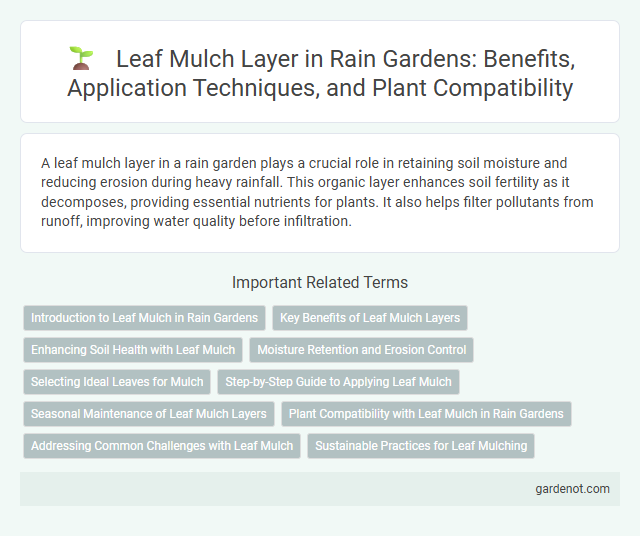A leaf mulch layer in a rain garden plays a crucial role in retaining soil moisture and reducing erosion during heavy rainfall. This organic layer enhances soil fertility as it decomposes, providing essential nutrients for plants. It also helps filter pollutants from runoff, improving water quality before infiltration.
Introduction to Leaf Mulch in Rain Gardens
Leaf mulch in rain gardens acts as a natural protective layer, enhancing soil moisture retention and reducing erosion. This organic layer promotes microbial activity and nutrient cycling, crucial for the health of plants in rain gardens. Proper application of leaf mulch also helps suppress weeds, maintaining the garden's ecological balance.
Key Benefits of Leaf Mulch Layers
Leaf mulch layers in rain gardens enhance soil moisture retention by reducing evaporation and promoting deeper water infiltration. They improve soil fertility through natural decomposition, enriching the soil with essential nutrients that support healthier plant growth. This organic layer also suppresses weed growth and moderates soil temperature, creating a stable microenvironment for diverse rain garden plants.
Enhancing Soil Health with Leaf Mulch
Leaf mulch layers in rain gardens improve soil health by increasing organic matter and promoting beneficial microbial activity. This natural mulch helps retain moisture, reduces erosion, and gradually releases nutrients, supporting plant growth and enhancing soil structure. Incorporating leaf mulch creates a sustainable environment that boosts soil fertility and resilience.
Moisture Retention and Erosion Control
A leaf mulch layer in a rain garden significantly enhances moisture retention by absorbing and slowly releasing water, which supports plant health during dry periods. This organic mulch also acts as a protective barrier, reducing soil erosion by minimizing the impact of heavy rainfall and surface runoff. By maintaining soil structure and preventing nutrient loss, leaf mulch promotes a stable and sustainable rain garden ecosystem.
Selecting Ideal Leaves for Mulch
Selecting ideal leaves for a rain garden mulch layer involves choosing deciduous leaves that decompose slowly to enhance soil structure and moisture retention. Oak, maple, and beech leaves are preferred due to their high tannin content and nutrient balance, which support beneficial microbial activity. Avoid using pine needles or leaves treated with pesticides, as they can alter soil pH and harm plant health.
Step-by-Step Guide to Applying Leaf Mulch
Apply a 2-3 inch layer of shredded leaf mulch evenly over the rain garden to retain moisture and suppress weeds. Begin by clearing debris and spreading mulch around plant bases without smothering stems. Regularly refresh the mulch layer each fall to enhance soil health and promote biodiversity in the rain garden ecosystem.
Seasonal Maintenance of Leaf Mulch Layers
Seasonal maintenance of leaf mulch layers in rain gardens involves replenishing mulch annually to preserve moisture retention and temperature regulation essential for plant health. Removing decomposed or compacted leaf litter prevents soil compaction and enhances aeration, promoting robust root growth. Monitoring mulch depth, ideally maintaining 2 to 3 inches, ensures effective suppression of weeds and sustains microbial activity for nutrient cycling.
Plant Compatibility with Leaf Mulch in Rain Gardens
Leaf mulch in rain gardens improves soil moisture retention and nutrient cycling, essential for supporting diverse native plants like sedges, ferns, and wildflowers. Selecting plant species compatible with leaf mulch ensures optimal root aeration and microbial activity, enhancing plant health and stormwater filtration efficiency. Properly matched mulch and vegetation reduce erosion and promote sustainable rain garden ecosystems.
Addressing Common Challenges with Leaf Mulch
Applying a leaf mulch layer in rain gardens significantly improves soil moisture retention and suppresses weed growth, addressing common challenges such as soil erosion and water runoff. Leaf mulch decomposes slowly, enriching soil organic matter and enhancing microbial activity, which strengthens plant health and resilience. Regularly replenishing the mulch layer prevents compaction and nutrient depletion, ensuring sustained ecosystem benefits and optimal rain garden performance.
Sustainable Practices for Leaf Mulching
Applying a leaf mulch layer in rain gardens enhances soil health by promoting nutrient cycling and moisture retention, supporting sustainable landscaping practices. Using locally sourced, shredded leaves reduces waste and provides a natural habitat for beneficial soil organisms, improving overall ecosystem function. Regularly replenishing the mulch layer prevents soil erosion and suppresses weed growth, maintaining the rain garden's effectiveness in stormwater management.
Leaf mulch layer Infographic

 gardenot.com
gardenot.com